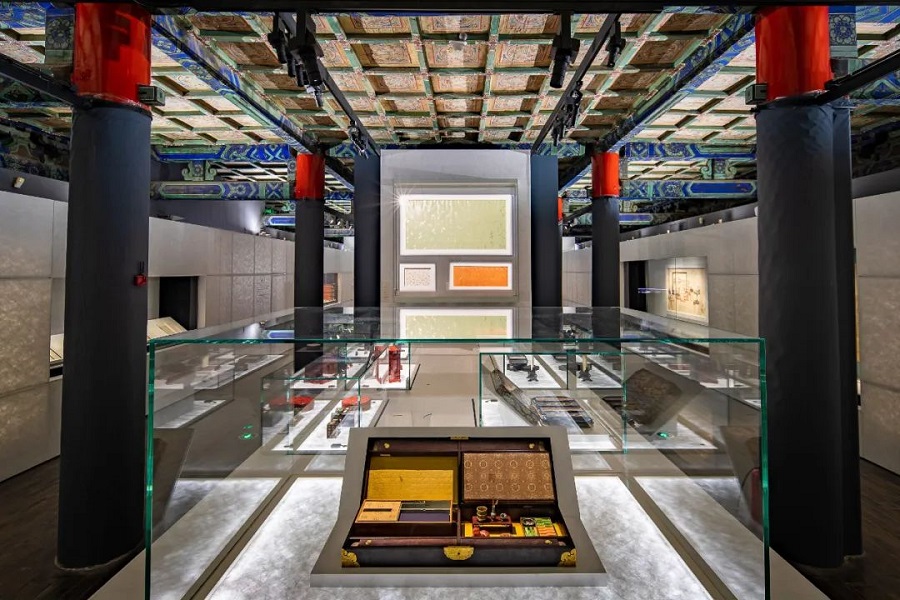
Nian Xu
Associate Professor, School of History and Culture, South China Normal University
The exhibition "Seeing the Heart of Heaven and Earth - the Meaning and Image of Chinese Study" recently launched by the Palace Museum has aroused heated discussion. The exhibition takes the study culture as the content, takes the meaning and image of the Chinese study as the theme, combines the works of contemporary artists, and makes the audience experience the cultural charm of the ancient scholar's study in an immersive way with the help of naked 3D, body feeling interactive projection and other technologies.
The study is an exhibition place of ancient Chinese traditional culture, and a personal "Taoist temple" for scholars. They have studied hard in the study and started their life course of "self-cultivation, family harmony, country governance, and world peace". Therefore, they often give their study titles such as "Xuan, Zhai, An, Tang, Lu". The study is also one of the ancient political decision-making spaces. In the Qing Dynasty, the academicians participated in government affairs by "entering the straight study", often known as "walking in the study". From emperors to ordinary literati, the collection, decoration and layout of their study are of great significance, and are the carriers reflecting the feelings and character of ancient Chinese literati.
Today, study culture, as a part of the excellent traditional Chinese culture, still plays an important role in the spiritual and cultural life of Chinese people. As long as conditions permit, many families will leave special space for reading, writing or other hobbies. This exhibition in the Forbidden City has built a bridge between traditional culture and modern life through topics rich in connotation and close to daily life and novel exhibition layout.
In recent years, ingenious boutique exhibitions such as "Seeing the Heart of Heaven and Earth" have emerged one after another throughout the country. "Going to museums to see exhibitions" has become a popular way of life and a new social trend for young people. Not only that, a series of creative cultural programs and activities, such as Tang Palace Banquet, National Treasures, and If National Treasures Can Speak, together with cultural subjects such as museums, have helped traditional culture become the focus of social attention. Under the joint force of the whole society, the excellent traditional Chinese culture has given birth to new vitality in the new era. Some of the essence of traditional culture once trapped in warehouses and books can go out of history and into the present through a new way. The report of the 20th National Congress of the Communist Party of China proposed that we should "promote cultural self-confidence and self-improvement, and create a new glory of socialist culture", "stick to the position of Chinese culture, and refine the spiritual logo and cultural essence of Chinese civilization". The excellent traditional Chinese culture is the profound fertile soil of socialist culture and the cornerstone of cultural self-confidence and self-improvement. We should further make good use of the treasure of China's excellent traditional culture, adhere to creative transformation and innovative development, constantly stimulate the vitality of traditional culture, and make it an inexhaustible source of nourishing the national spirit.
First of all, we should deeply grasp the essence of Chinese excellent traditional culture. Creative transformation and innovative development emphasize change, but the premise of change is to stick to the core and essence of Chinese culture. Only by understanding and grasping the traditional culture from the source and deep level can the unique spiritual identity of Chinese civilization different from other civilizations be truly displayed in the transformation and development. For example, the opening exhibition of the Forbidden City this year, "Why China", guided the audience to trace the origin and development of Chinese civilization with imagery expression, and pondered the grand proposition of "Why China is today's China". The exhibition was widely praised by virtue of its profound interpretation of the essence of China's excellent traditional culture.
Secondly, we need to fully tap the cross era value of Chinese excellent traditional culture. Traditional culture has its own characteristics of the times in the process of its formation. The creative transformation is to break through the limitations of its original era, find its aesthetic value, ideological value, and cultural value that meet the needs of the times and transcend the times, make the past serve the present, and respond to the needs of the times. For example, all kinds of traditional national costumes such as Han style clothes are increasingly popular among young people. In this trend, the concept of class division represented by the clothing color and pattern has been abandoned. Instead, the combination and innovation of traditional costume culture and contemporary aesthetics in style, material, pattern and other aspects have brought people fresh aesthetic experience.
At the same time, we should also pay attention to serving the public close to life. Although some excellent traditional cultures are recognized by people, they are still fading out of our vision, which is rooted in the distance between them and public life. This requires us to find a closer entry point in the process of promoting traditional culture, and let traditional culture enter and integrate into people's daily life through ingenious conception and innovative display methods. The innovation of the exhibition of "Seeing the Heart of Heaven and Earth" in the Forbidden City lies not only in the use of modern technology, but also in its unique theme planning, which has promoted the audience to consciously use excellent traditional culture under subtle influence.
